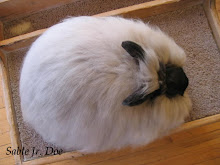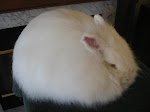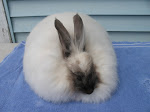--another post from the old blog
Someone asked me a very good question the other day, and I remember that this was something that confused me too when I began raising rabbits, so I thought I would write a post about it:).
The question had to do with what would happen if you clipped a coat before it was technically ready to molt----would the growth that began again be considered the new coat or simply an old coat continuing to grow out?
The answer to this question can be understood when we take a look at how an Angora coat cycles. Hold times for Angora coats rely on many different factors--different breeds hold coats for different lengths of time with the English Angora being capable of holding a coat for 12-15 months while the German and Giant Angora coats never "truly" molt, either. As of now the Satin and French Angora coats hold for the smallest amount of time, with the French ranging anywhere from 4-10 months and the Satins holding approx. the same amount of time (*I have never raised SAs, btw, so it is possible this estimation is not 100% accurate).
Other factors that affect rate of wool growth and hold time are genetics (different lines hold for different periods of time), climate, stress, and nutrition. Also, the time of year can play a significant part in how a coat grows, which is why it is important to account for faster growth in the winter and slower growth in summer when planning your breeding schedule.
After harvest (assuming that the harvest was done at molt time), an angora coat will begin to grow back in at the rate of about 1 inch per month. Some rabbits grow wool more quickly and others grow it back more slowly, but the average rate is 1 inch. Also, as mentioned above, the wool grows back more slowly in summer to keep the rabbit cooler, and more quickly in winter to keep it warmer.
Typically (and I am using the growth of my own line as an example), the first 3 months of growth are the "building" phase of the coat. Wool is actively growing at this time and the rabbit is eating a substantial amount of food to supply the protein needed to maintain growth.
At about the beginning of the 4th month, the coat begins to Prime, which is the desired phase to Show or harvest Prime spinning wool in. The tips of the coat are well-defined at this point and the coat has decent length (it should be 4 inches long at least), and this is the point at which wool growth begins to slow down. In my own herd, this is considered the peak time for the coat, and full Prime condition remains for approx. 6 weeks longer (which is why I breed them to be entering this phase for the biggest shows).
At 5-5 1/2 months of age, the coat begins to slip. Growth has ceased entirely at this point and the condition of the coat begins to decline and trail off in strings and strands of loose fiber. Also, the rabbit begins to eat less now because excess protein is no longer needed once the period of growth is over.
At 6-7 months the coat goes into a complete molt and it is time to remove it. At this point it is critical to harvest the fleece because it becomes dangerous for the rabbit to consume loose wool during self-grooming. A molting coat is completely dead and finished, so once you clip the wool in this stage the new coat will rapidly begin growing in underneath, and you will begin the cycle of growth all over again.
What would happen if you were to interrupt the cycle by clipping a rabbit before the coat was molting or even in the slipping stage? The answer is, absolutely nothing---the cycle will continue on as though the clip never took place.
An Angora coat cannot be manipulated to change it's growth pattern according to when the coat is harvested. If a coat is clipped early, the same hair shafts will simply continue to grow out (minus the tips), until the stage of molt is reached. At this point the hairs will release completely from the follicles, fall out, and new hairs will take their place and begin to grow again. If you find that you are forced to clip early for any reason (such as a heat wave or pregnancy, etc), then don't worry, simply mark down the date of the clip on your calendar, and then clip again as soon as the existing coat begins to slip/molt on it's normal schedule. Once this happens, the old coat is gone for good and you are back to Stage 1:).
This is just an overview of a typical FA growth pattern. As I mentioned earlier, various factors can influence growth on individual animals, so it is important to make your own observations and learn when to identify the signs of a slipping coat in your herd.
Saturday, April 4, 2009
Subscribe to:
Post Comments (Atom)























No comments:
Post a Comment